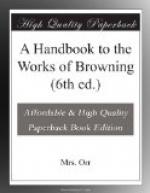The poem is followed by an historical appendix, which enables the reader to verify its facts, and judge Mr. Browning’s interpretation of them.
“SORDELLO.” (1840.)
“Sordello” is, like “Paracelsus,” the imaginary reconstruction of a real life, in connection with contemporary facts; but its six “books” present a much more complicated structure. The historical part of “Paracelsus” is all contained in the one life. In “Sordello” it forms a large and moving background, which often disputes our attention with the central figure, and sometimes even absorbs it: projecting itself as it were in an artistic middle distance, in which fact and fancy are blended; while the mental world through which the hero moves, is in its way, as restless and as crowded as the material. It may save time and trouble to readers of the poem to know something of its historical foundation and poetic motive, before making any great effort to disentangle its various threads; but it will always be best to read it once without this key: since the story, involved as it is, has a sustained dramatic interest which is destroyed by anticipating its course.
The historical personages who take part in it directly and indirectly, are
Ghibellines. Guelphs.
ECCELINO DA ROMANO II.,
AZZO, LORD OF ESTE
Surnamed the Monk: (father
and son).
married, first to Agnes
Este; secondly to Adelaide, RICHARD, COUNT
OF SAN
a Tuscan. BONIFACIO
(father and
son).
TAURELLO SALINGUERRA,
a soldier, married, first to
Retrude, of the family of
the German Emperor
Frederick the Second;
and secondly, in advanced
life, to Sofia, fifth
daughter of Eccelino the
Monk.
ADELAIDE, second wife
of
Eccelino da Romano.
PALMA (properly Cunizza),
Eccelino’s daughter
by
Agnes Este.
The poet SORDELLO.
Historical basis of the Story.
A Mantuan poet of the name of Sordello is mentioned by Dante in the “Purgatorio,” where he is supposed to be recognized as a fellow-townsman by Virgil.
“Surse
ver lui del luogo ove pria stava,
Dicendo,
O Mantovan, Io son Sordello
Della tua
terra: e l’ un l’ altro abbracciava."[12]
And also in his treatise “De vulgare Eloquentia,” where he speaks of him as having created the Italian language. These facts are related by Sismondi in his “Italian Republics,” vol. ii., page 202; and the writer refers us for more particulars to his work on the “Literature of Southern Europe.” He seems, however, to exhaust the subject when he tells us that the nobility of Sordello’s birth, and his intrigue or marriage with Cunizza are attested by contemporaries; that a “mysterious obscurity” shrouds his life; and that his violent death is obscurely indicated by Dante, whose mention of him is now his only title to immortality. According to one tradition he was the son of an archer named Elcorte. Another seems to point to him when it imputes a son to Salinguerra as the only offspring of his first marriage, and having died before himself. Mr. Browning accepts the latter hypothesis, whilst he employs both.




